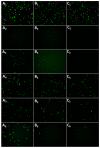Liposomes-In-Hydrogel Delivery System Enhances the Potential of Resveratrol in Combating Vaginal Chlamydia Infection
- PMID: 33322392
- PMCID: PMC7764002
- DOI: 10.3390/pharmaceutics12121203
Liposomes-In-Hydrogel Delivery System Enhances the Potential of Resveratrol in Combating Vaginal Chlamydia Infection
Abstract
Chlamydia trachomatis is the most common cause of bacterial sexually transmitted infections and causes serious reproductive tract complications among women. The limitations of existing oral antibiotics and treatment of antimicrobial resistance require alternative treatment options. We are proposing, for the first time, the natural polyphenol resveratrol (RES) in an advanced delivery system comprising liposomes incorporated in chitosan hydrogel, for the localized treatment of C. trachomatis infection. Both free RES and RES liposomes-in-hydrogel inhibited the propagation of C. trachomatis in a concentration-dependent manner, assessed by the commonly used in vitro model comprising McCoy cells. However, for lower concentrations, the anti-chlamydial effect of RES was enhanced when incorporated into a liposomes-in-hydrogel delivery system, with inhibition of 78% and 94% for 1.5 and 3 µg/mL RES, respectively for RES liposomes-in-hydrogel, compared to 43% and 72%, respectively, for free RES. Furthermore, RES liposomes-in-hydrogel exhibited strong anti-inflammatory activity in vitro, in a concentration-dependent inhibition of nitric oxide production in the LPS-induced macrophages (RAW 264.7). The combination of a natural substance exhibiting multi-targeted pharmacological properties, and a delivery system that provides enhanced activity as well as applicability for vaginal administration, could be a promising option for the localized treatment of C. trachomatis infection.
Keywords: Chlamydia trachomatis; antimicrobial; chitosan; hydrogel; liposomes; resveratrol; vaginal therapy.
Conflict of interest statement
The authors declare no conflict of interest.
Figures



References
-
- Rowley J., Vander Hoorn S., Korenromp E., Low N., Unemo M., Abu-Raddad L.J., Chico R.M., Smolak A., Newman L., Gottlieb S. Chlamydia, gonorrhoea, trichomoniasis and syphilis: Global prevalence and incidence estimates 2016. Bull. World Health Organ. 2019;97:548–562. doi: 10.2471/BLT.18.228486. - DOI - PMC - PubMed
Grants and funding
LinkOut - more resources
Full Text Sources

